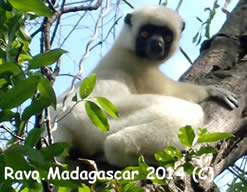Sifaka lemur, or Propithecus species ( revised on February 2012 ),
Is from Family Indridae, genus Propithecus.
This family contains 14 species arranged between three genera. Two genera : Indri and Propithecus are diurnal and Avahi is smaller and nocturnal.
Sifaka lemur moves on its side when it moves on the ground, it is the reason of its appellation : « Dancer Lemur ». So it is the most splendid to observe. When Sifaka lemur is on tree, it moves with bounding leaps between vertical trunks and branches, it is the reason of its appellation : « Jumping Lemur », so Sifaka lemur can leap 10 meters from tree to tree using just their hind legs.
Sifaka lemurs inhabits
Both dry deciduous forests, xerophytic spiny forests, gallery forests, semi-evergreen forests and primary and slightly degraded rainforests. One of the most indicated spot for its observation is Andohahela National Park ( Fort Dauphin at the deep south part of Madagascar ) or Mantadia National Park or Ranomafana National Park ( eastern Madagascar rainforests ).
Strictly diurnal, Sifaka lemur ( called « Simpona » in rainforest regions ) eats chiefly leaves & fruits ( tamarinds, mangos … ) but also seeds and flowers, sometimes bark in dry season, and it passes 40 % of its times to eat in the trees ( so they are arboreal ). Sifaka lemur does not need to drink because it obtains all water which it needs in its food.

a western Sifaka species : the Decken's Sifaka and
its photographer Ravo in the Tsingy of Bemaraha©
The western and southern Sifaka lemurs are ( the most common at first ) :
- Propithecus verreauxi - Verreaux's Sifaka ( overall white with very dark grey to black face )
- Propithecus deckeni - Decken's Sifaka ( creamy-white all over with face entirely black )
- Propithecus coquereli - Coquerel's Sifaka (mostly white-inner face black surrounded by white)
- Propithecus coronatus - Crowned Sifaka ( creamy-white all over with face mainly dark grey )
The eastern and northern Simpona lemurs are ( the most common at first ) :
- Propithecus diadema - Diademed Sifaka (variation in coloration - head white with black crown)
- Propithecus edwarsi - Milne-Edwards's Sifaka ( from dark chocolate-brown to black on head )
- Propithecus candidus - Silky Sifaka ( silky creamy-white with face slate-grey to black )
- Propithecus tattersalli - Golden-crowned Sifaka ( creamy-white with yellow-orange crown )
- Propithecus perrieri - Perrier's Sifaka (uniformly black - one of the most endangered primates)
Madagascar : the Tsingy, Nosy Be area, Baobab
Here is the Black and white ruffed lemur
Sifaka lemurs live in small groups
Of 2 to 14 individuals ( 4 to 8 is average ), in a territory of 2 to 35ha ( up to 60ha in continuous forest ) following their habitats, a territory is marked by anal odor. Females dominate the group. Such as all Indridae famillies, Sifaka lemur moves by jumps from tree to tree or from trunk to trunk. Babies are born in June or July, after a 160-180 days gestation.
At the beginning, their mothers carry them like a belt around their size ; then after few months, the mother put the baby on its back and the baby becomes independent when it is 6 months years old. Smaller groups ( 6 or less ) represent family units.

Decken's Sifaka and the Tsingy National Park area - Ravo 2014©
Ravo's 2005-2008© pictures - Tsingy of Bemaraha National Park
Predation and Lifespan of the Dancer Lemur - Madagascar :
Infant predation is high, around 30 % are taken by Fosa Cryptoprocta ferox. A captive member of Sifaka lemur is known to have lived more than 23 years in captivity. It is likely that the lifespan in the wild is somewhat shorter than this. But Average lifespan ( in captivity ) is 18 years.